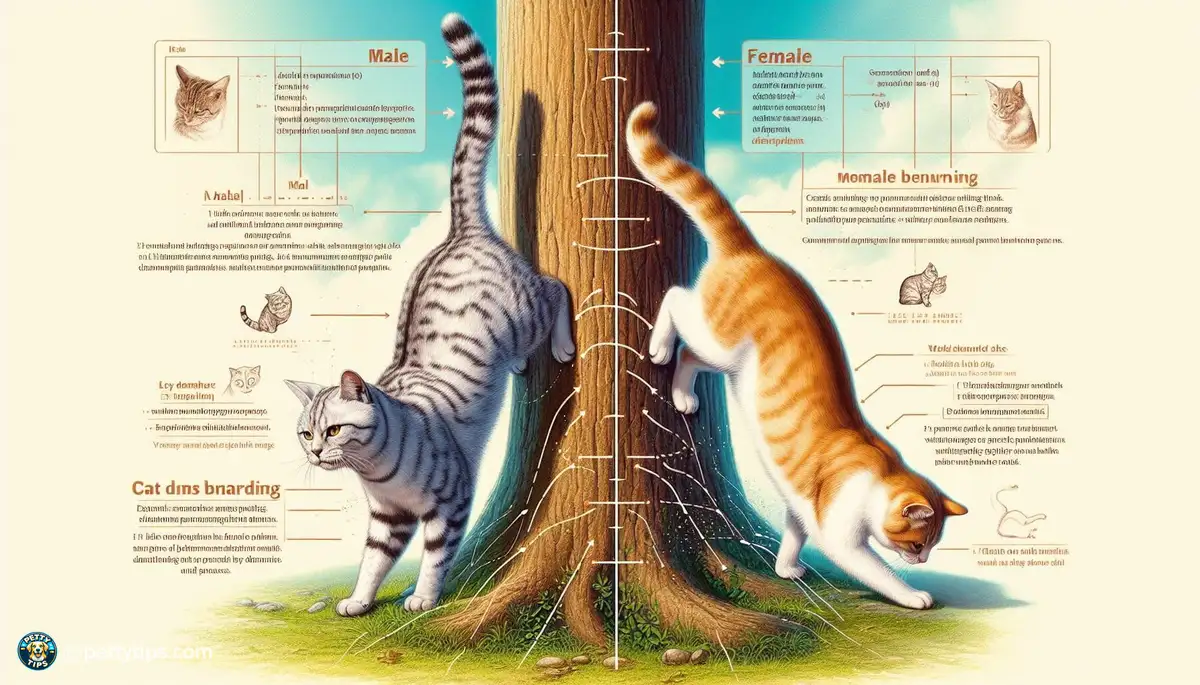- Home
- Cat Behavior
- The Influence of Gender on Cat Marking Behavior
The Influence of Gender on Cat Marking Behavior

What is Cat Marking?
Cat marking, also known as spraying, is a natural behavior where cats deposit urine in specific locations to communicate with other cats. While both male and female cats engage in marking behavior, there are notable differences influenced by gender.
Cats have specialized scent glands located in various parts of their bodies, including their cheeks, paws, and the base of their tails. When a cat sprays, they release a combination of urine and pheromones that convey important information to other cats in the area.
Why Do Cats Mark?
Marking serves several purposes for cats, including territory marking, communication, and reproductive signaling. By leaving their scent in strategic locations, cats establish boundaries, advertise their presence to potential mates, and convey social information to other cats in their environment.
For intact male cats, marking behavior is often driven by territorial instincts and the need to assert dominance. In contrast, female cats may also mark territory, but they are more likely to engage in marking behavior during their estrus (heat) cycle to attract potential mates.
How to Differentiate Marking from Inappropriate Elimination
It's essential to differentiate between marking behavior and inappropriate elimination, which is when a cat urinates or defecates outside of the litter box. While marking typically involves small amounts of urine deposited on vertical surfaces, inappropriate elimination usually involves larger volumes of urine on horizontal surfaces, such as floors or beds.
Determining the underlying cause of a cat's urination behavior is crucial for implementing effective management strategies. Marking behavior is often influenced by social and territorial factors, while inappropriate elimination may be triggered by medical issues, stress, or litter box aversion.
Gender Differences in Cat Marking Behavior
Male Cat Marking Behavior
Male cats, especially those that are intact (not neutered), are more prone to marking behavior than female cats. Testosterone plays a significant role in influencing male cat marking, as intact males may mark territory more frequently and aggressively to establish dominance and attract mates.
Intact male cats may begin marking as early as puberty, typically around six months of age. However, neutering can significantly reduce marking behavior in male cats, as it decreases testosterone levels and diminishes the urge to scent mark.
Female Cat Marking Behavior
While female cats are less likely to mark territory than intact males, they may still engage in spraying behavior, particularly during their estrus cycle. When female cats are in heat, they may mark to signal their readiness to mate and attract potential suitors.
Female cat marking tends to be less frequent and less intense compared to male marking behavior. However, spaying female cats can help prevent unwanted litters and reduce the likelihood of marking associated with the estrus cycle.
Environmental Triggers for Marking
In addition to gender differences, environmental factors can also influence cat marking behavior. Changes in the household, such as the introduction of a new pet, moving to a new home, or rearranging furniture, can trigger marking behavior in both male and female cats.
Stressful situations, such as conflict with other pets or unfamiliar noises, may also prompt cats to mark territory as a coping mechanism. Providing a stable and enriched environment, along with ample opportunities for mental and physical stimulation, can help reduce stress and minimize marking behavior.
Managing Cat Marking Behavior
Neutering and Spaying
One of the most effective ways to manage cat marking behavior is through neutering and spaying. For male cats, neutering reduces testosterone levels and diminishes the urge to mark territory. Similarly, spaying female cats eliminates the hormonal fluctuations associated with the estrus cycle, reducing the likelihood of marking behavior.
Neutering and spaying are recommended for both behavioral management and population control. By preventing unwanted litters, pet owners can help reduce the number of homeless cats in their communities while also addressing marking behavior.
Environmental Enrichment
Providing a stimulating and enriched environment is essential for preventing and managing cat marking behavior. Cats thrive on mental and physical stimulation, so offering interactive toys, scratching posts, and vertical climbing spaces can help satisfy their natural instincts and prevent boredom-related marking.
Creating multiple litter box stations in different areas of the home can also discourage marking behavior by providing ample opportunities for appropriate elimination. Additionally, using pheromone-based products, such as synthetic feline facial pheromones, can help calm anxious cats and reduce the urge to mark territory.
Behavior Modification Techniques
In some cases, behavior modification techniques may be necessary to address persistent marking behavior in cats. positive reinforcement training, such as rewarding desired behaviors like using the litter box, can help redirect cats' focus away from marking.
Consistency is key when implementing behavior modification techniques, and patience is required as cats may take time to adjust to new routines. Avoid punishment-based methods, as they can exacerbate stress and potentially worsen marking behavior.
Conclusion
Understanding the influence of gender on cat marking behavior is essential for pet owners seeking to manage and prevent this natural instinct. While both male and female cats may engage in marking behavior, there are notable differences driven by hormonal factors and social dynamics.
By addressing underlying causes, such as hormonal fluctuations, environmental stressors, and social dynamics, pet owners can implement effective management strategies to minimize marking behavior. Through a combination of neutering and spaying, environmental enrichment, and behavior modification techniques, pet owners can help their cats live happy and harmonious lives in their homes.
